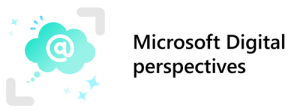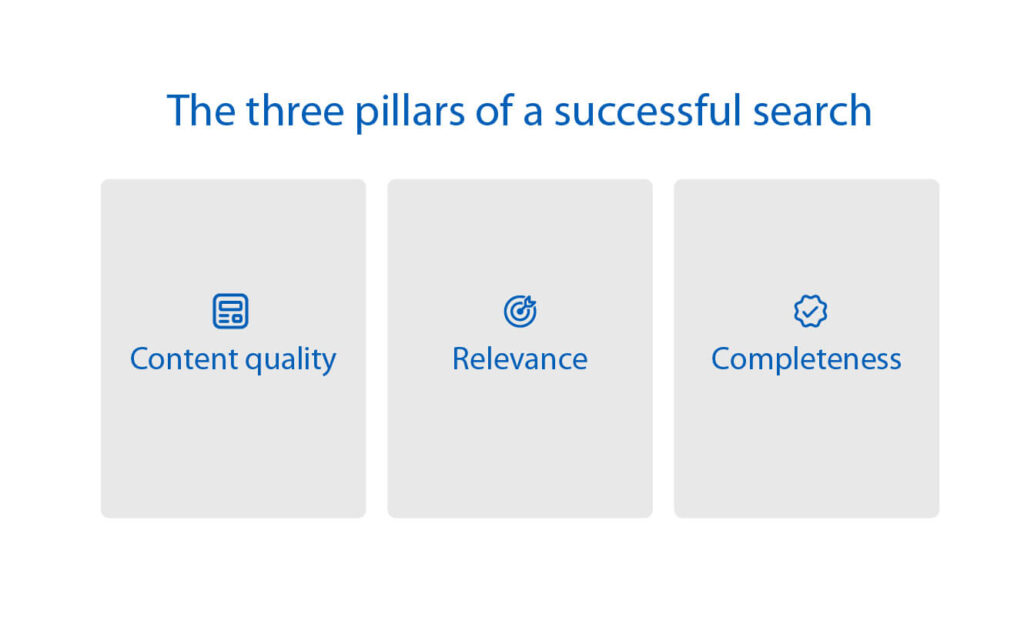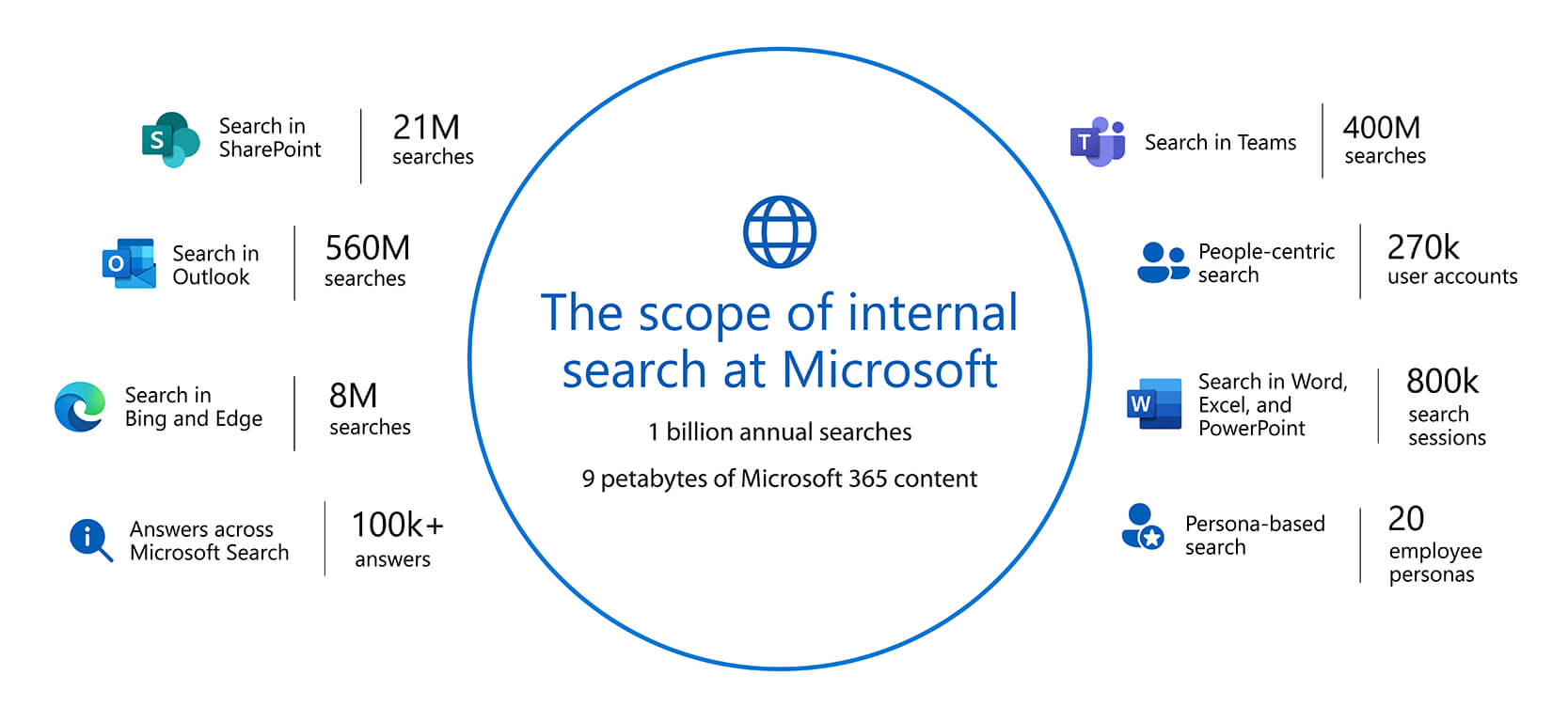 Microsoft has more than 220,000 employees working around the globe. Collectively, they conduct 1 billion searches annually across many petabytes of content. Helping our employees find that information quickly and accurately can be a challenge, but our team is improving the employee knowledge-finding experience through Microsoft Search, Microsoft’s modern enterprise search experience.
Microsoft has more than 220,000 employees working around the globe. Collectively, they conduct 1 billion searches annually across many petabytes of content. Helping our employees find that information quickly and accurately can be a challenge, but our team is improving the employee knowledge-finding experience through Microsoft Search, Microsoft’s modern enterprise search experience.

Our employee base breaks out into countless personas that have vastly different search interests and need a wide range of content sources to power their work. Those content sources can be file shares, Microsoft SharePoint sites, documents or other files, and internal websites. Our employees also frequently access external sources like Human Resources partner sites.
Seven years ago, Microsoft made it a priority to optimize the search experience, both to support employees in their work and reclaim time lost to inefficient searches. According to one study at the time, employees spent an average of more than nine hours each week searching and gathering information. So we began a program to deliver a successful search experience to employees organization-wide using Microsoft Search.
[See how Microsoft is administering search to generate great results. | Read about the ways that Microsoft is redefining the digitally assisted workday. | Learn about Microsoft’s reinvented employee experience for the hybrid world.]
Enhancing search for a better employee experience
Our ongoing work to achieve successful search relies on three interconnected pillars.

- Content Quality: The content needs to be accurate and well-maintained. At the same time, it should support current conversations between experts and contacts across the company.
- Relevance: At its core, relevance means ranking the right items at the top of the search result list. It also includes UX elements that help people filter and tune their results, and an engine that understands the user’s intent.
- Completeness: A complete search references as much appropriate content across the company as possible, wherever it’s found. Meanwhile, it needs to respect permissions so that individuals only see information they’re entitled to access.
To be successful, our work must address each of these pillars. Each of them is interconnected, so collaboration is crucial. We work alongside content owners across the company, search portal owners from multiple divisions, and many partners within Microsoft Search product teams.
We also source insights through employee communication and support channels, harvest analytics through the Search Admin Center paired with the custom telemetry we collect, and leverage user surveys, studies, and other forms of feedback. Between our cross-company partners and these data sources, we’re continually working to ensure search at Microsoft becomes more helpful and successful year after year.
People-driven, behavior-supportive search
As we work to enhance the search experience at Microsoft, we need to consider three factors carefully.
- Employee personas: A company as large as Microsoft encompasses many different employee personas, and each of them have different expectations for content quality, relevance, and completeness. We commonly cluster personas around three factors: their organization within the company, their profession, and their geographic location. For example, a salesperson working in Latin America has vastly different search interests than an engineer working in China. As a result, it can be challenging to accommodate the profoundly different interests of those two employees while enabling them both to search efficiently.
- Search vectors: We separate search activities into two logical sets. The first is enterprise-wide search, where users don’t know the exact source for the material they’re seeking but want to find appropriate content from across the company. Enterprise-wide search frequently takes place in internal, Microsoft-wide tools. The second search vector is tool-specific. For this vector, users search within Microsoft Outlook, SharePoint, Teams, and other applications or tools they’re using. They’re expecting to find the content they want within that interface.
- Search behaviors: We’ve also categorized users’ search behaviors into two sets. The first is quick-find, also known as re-find. In a quick-find search, the employee knows that something exists and has likely searched for it before. They just want to get to that content. Quick-find searches account for the majority of our enterprise-wide search volume. We also see research behaviors. When employees are researching or investigating, they need information or an answer that requires in-depth content wayfinding, reading, analysis, or review. Approximately 30 percent of our enterprise-wide search volume comes from research-driven behavior.

A multifaceted approach to implementing Microsoft Search
Improving enterprise-wide search in an organization as large and complex as Microsoft is a massive undertaking, so it’s helpful to break our efforts out into a few key baskets that match our main pillars: content quality, relevance, and completeness.
- Content quality
- Reporting and insights for content owners to identify and manage old and outdated content
- Tools and processes to simplify content classification with metadata
- Maintaining common vocabulary in a centralized corporate taxonomy
- Relevance
- Improved relevance with advancement in semantic understanding and additional results such as search answers
- Upgrading the many common search portals around the company
- Improved understanding of intent in the search box to provide user options like suggestions
- Utilizing Search Admin capabilities like bookmarks to deliver the right results on common searches quickly
- Completeness
- Adding content from across Microsoft
- Targeting content to the persona audience we expect to use it
- Coordination with organization-specific search portals and cooperating with them rather than competing with them
Over the life of this project and in close collaboration with our product partners, our team has co-developed more than ten experiences for Microsoft Search that align with these efforts. They range from spell-check suggestions in SharePoint Online to personal query history management that helps our users search more successfully. We also strive to leverage all the features delivered in the product to improve the user experience—bookmarks, locations, acronym data mining, connectors, and many more.
When approaching this kind of company-wide implementation, it’s important to keep three principles in mind.
- Leverage capabilities in first-party products as much as possible.
- Make any custom work as general as possible so it can be used across the whole company.
- Partner with different parties and encourage individual initiatives around the company so our program doesn’t have to create every solution.
The impact so far
After seven years, we’ve improved the search experience at Microsoft to the point that we’re seeing both productivity impacts and increased user satisfaction. Our team has modernized over 500,000 SharePoint Online sites with Microsoft Search, enabled several new content types for better searchability, and migrated 12 major internal portals.
As a result, search-session success rate (SSR) has climbed 30-40 percent since our efforts began. Meanwhile, Microsoft’s internal scale that registers user search satisfaction has soared from 87 to 125 on a scale of 200, representing growth of over 43 percent.
And we’re not finished. As we continue to work with groups across Microsoft, the employee experience benefits and productivity boost of optimized search experiences will only continue, and we’re intent on sharing the lessons we’ve learned.
This post is the first in a series outlining the different components of our Microsoft Search implementation journey. Over the coming months, we’ll be sharing in-depth looks into different elements of our improvement efforts, from reimagining the workday in a knowledge-seeking context to optimizing search across endpoints.
Follow along and find out how your organization can make internal search an effective experience for your employees and a productivity driver for your company.

- The functionality you need probably exists: Leverage existing capabilities wherever you can.
- Understand your major user personas, the information, and their habits in finding it.
- Don’t repeatedly reinvent: Make customer work as general as possible to meet diverse needs.
- Your partners are great resources: Give them the agency and initiative to follow their ideas and create solutions.
- Handholding is crucial: When you’re working with a diverse set of teams, put together clear documentation.
- Early insights are incredibly helpful: Offer early access for feedback and testing.
- Data drives insights: Look at user research from as many sources as possible.

- Learn more about using Microsoft Search internally at Microsoft.
- See how Microsoft is administering search to generate great results.
- Read about the ways that Microsoft is redefining the digitally assisted workday.
- Learn about Microsoft’s reinvented employee experience for the hybrid world.
Want more information? Email us and include a link to this story and we’ll get back to you.






